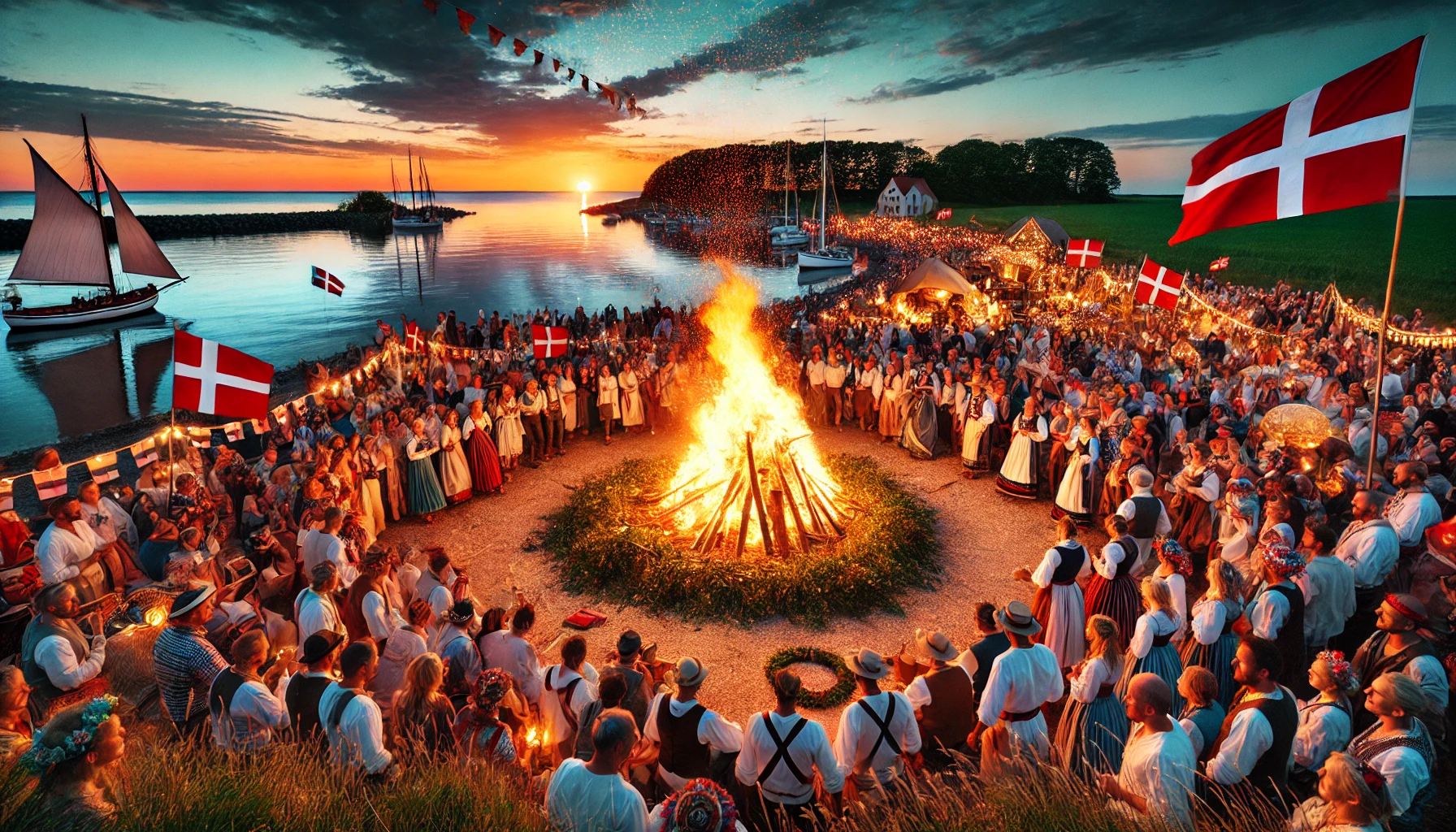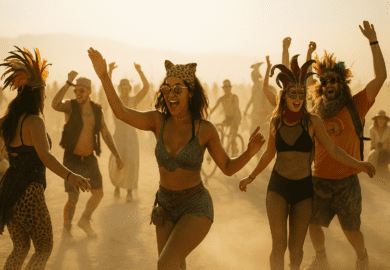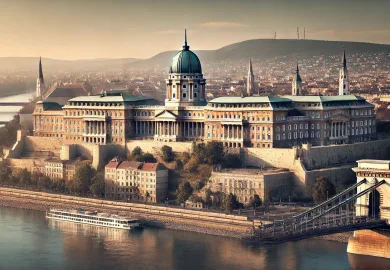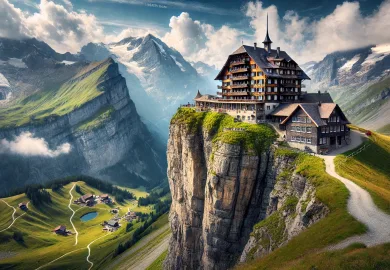
Sankt Hans, also known as Midsummer Eve, is a deeply cherished celebration in Denmark, bringing together communities in a vibrant display of tradition, culture, and festivity. Marked by large bonfires, songs, and joyous gatherings, Sankt Hans is not just a summer festival but a significant cultural event that encapsulates the Danish spirit of togetherness. This article delves into the history, traditions, and modern-day celebrations of Sankt Hans, offering a comprehensive guide to one of Denmark’s most beloved festivities.
The Origins of Sankt Hans: A Blend of Paganism and Christianity
Sankt Hans is celebrated on the evening of June 23rd, coinciding with the summer solstice, the longest day of the year. The roots of Sankt Hans can be traced back to both pagan and Christian traditions, creating a unique blend that is celebrated today.
Historically, the summer solstice was a time of pagan rituals, where people would light fires to ward off evil spirits and ensure a good harvest. These fires, symbolic of the sun’s power, were believed to protect against witches and other malevolent forces. With the spread of Christianity, this pagan festival was Christianized, and the day became associated with Saint John the Baptist, known as Sankt Hans in Danish.
Over the centuries, the celebration evolved, merging these pagan and Christian elements into a singular festival. The bonfires, which once served as a protective measure against witches, became a central part of the celebration, symbolizing the triumph of light over darkness. Today, Sankt Hans is a time for Danes to come together, honoring both their ancient traditions and their community spirit.
Modern-Day Celebrations: A Night of Fire and Festivity
In contemporary Denmark, Sankt Hans is a night filled with communal gatherings, music, and, of course, bonfires. The celebration typically begins in the late afternoon, as families and friends gather in parks, beaches, and other public spaces.
As the sun begins to set, the anticipation builds for the lighting of the bonfire, the focal point of the evening. These bonfires are often large, and it is customary to place an effigy of a witch on top, a nod to the festival’s ancient roots. The burning of the witch symbolizes the banishment of evil and the protection of the community from harm. This tradition, while rooted in superstition, is now more of a symbolic gesture, embraced by people of all ages.
Music plays a vital role in the Sankt Hans festivities. Traditional songs, such as “Vi elsker vort land” (We Love Our Country), are sung around the bonfire, fostering a sense of unity and national pride. Many events also feature live performances, with bands playing everything from folk music to modern pop, ensuring that there is something for everyone to enjoy.
The Symbolism Behind the Bonfire: Light, Community, and Renewal
The bonfire is more than just a spectacular sight; it carries deep symbolic meaning in the context of Sankt Hans. The fire represents the light of the sun at its peak, a force that has been celebrated by cultures around the world during the summer solstice.
In Denmark, the bonfire also symbolizes the power of the community. As people gather around the fire, they are participating in a ritual that has been performed for centuries, connecting them to their ancestors and to each other. The communal nature of the bonfire reinforces the idea that, together, people can overcome the darkness, both literal and metaphorical.
Additionally, the burning of the witch effigy is a symbolic act of renewal. It represents the clearing away of old, harmful forces to make way for new beginnings. This idea of renewal is central to Sankt Hans, as it marks the turning point of the year when the days will begin to shorten once more, reminding everyone of the cyclical nature of life.
Sankt Hans Around Denmark: Popular Spots to Celebrate
While Sankt Hans is celebrated all across Denmark, certain locations have become particularly popular for their picturesque settings and lively atmospheres. These spots offer a quintessential Sankt Hans experience, combining natural beauty with traditional festivities.
Aarhus: The City by the Sea
Aarhus, Denmark’s second-largest city, is a favorite destination for Sankt Hans celebrations. The city’s beaches and parks, such as Marselisborg Mindepark, provide stunning backdrops for the bonfires. The reflections of the fire on the water create a magical atmosphere, making Aarhus a memorable place to experience Sankt Hans.
In addition to the bonfires, Aarhus often hosts cultural events, including concerts and performances, adding an extra layer of entertainment to the evening. The combination of natural beauty, community spirit, and cultural offerings makes Aarhus a top choice for those looking to celebrate Sankt Hans in style.
Skagen: Where Two Seas Meet
Skagen, located at the northern tip of Denmark, is another iconic spot for Sankt Hans. Known for its unique geography, where the North Sea and the Baltic Sea meet, Skagen provides a dramatic setting for the midsummer festivities. The long stretch of sandy beaches makes it an ideal location for bonfires, drawing both locals and tourists alike.
The Sankt Hans celebrations in Skagen often include traditional Danish food, music, and dancing, giving visitors a full immersion into Danish culture. The sense of history and tradition is palpable in Skagen, making it a perfect destination for those who want to experience the authentic spirit of Sankt Hans.
Copenhagen: A Capital Celebration
In Copenhagen, the capital city of Denmark, Sankt Hans is celebrated with great enthusiasm. The city’s parks, such as Frederiksberg Gardens and Fælledparken, host some of the largest bonfires, attracting thousands of people. The urban setting gives Sankt Hans in Copenhagen a different vibe, blending the old traditions with a modern, cosmopolitan atmosphere.
Copenhagen’s Sankt Hans celebrations are often accompanied by fireworks, adding to the spectacle of the evening. The city’s vibrant nightlife also means that the festivities can continue long into the night, with bars and clubs offering special events to mark the occasion. For those looking to combine tradition with contemporary fun, Copenhagen is an ideal place to celebrate Sankt Hans.
Embracing the Future: Sustainability and Sankt Hans
As with many cultural traditions, Sankt Hans is evolving to meet the demands of the modern world, particularly concerning environmental sustainability. In recent years, there has been a growing awareness of the environmental impact of the bonfires, leading to efforts to make the celebrations more eco-friendly.
Some communities have started using more sustainable materials for the bonfires, such as untreated wood and natural decorations, to reduce harmful emissions. Additionally, there is a push to minimize waste and encourage recycling during the festivities. These efforts ensure that Sankt Hans can continue to be a cherished tradition for generations to come, without compromising the environment.
The move towards sustainability also reflects a broader trend in Danish society, where environmental consciousness is deeply ingrained. By incorporating these values into the Sankt Hans celebrations, Denmark is ensuring that this ancient tradition remains relevant and responsible in the modern age.
Sankt Hans is a vibrant celebration that beautifully encapsulates Denmark’s rich cultural heritage. With its roots in both pagan and Christian traditions, the festival has evolved into a beloved national event that brings people together in a spirit of joy and community. Whether you experience it in a bustling city like Copenhagen, a scenic coastal town like Skagen, or anywhere else in Denmark, Sankt Hans offers a unique glimpse into the heart of Danish culture. As the flames of the bonfire rise into the night sky, they carry with them the warmth, unity, and enduring traditions of this special time of year.








